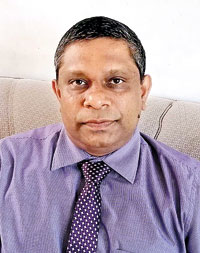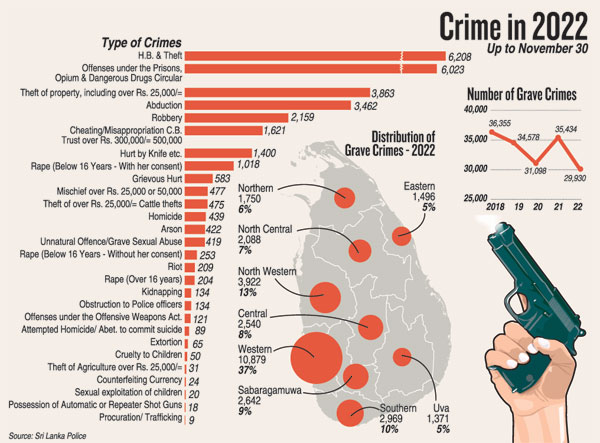News
Pera study proves link between economic crisis and rising crime rate
View(s):- Senior professor calls on authorities to work out comprehensive plan to deal with fast-deteriorating situation
By Senuka Jayakody
The current economic crisis has contributed to a sharp rise in the crime rate, a study carried out by Peradeniya University’s Economics Professor Wasantha Athukorala has revealed .

Wasantha Athukorala, Economics Professor, Peradeniya University
“There is a strong correlation between the crime rate and the economic crisis. When poverty increases, the crime rate increases,” he said.
The professor said that given the increase in poverty in Sri Lanka with people losing their jobs and experiencing a decline in their income during the past two to three years, there was an academic need to observe the rise in crime rates against the changing backdrop.
Though statistics from the Police Department, on grave crimes, reported a gradual decrease in the crime rate from 2010 to 2020, the chart showed a picking-up in 2021. Police recorded 57,750 grave crimes in 2010 and 31,098 cases in 2020. But in 2021, the number rose to 35,434.
Up to November 30 last year, 29,930 grave crime cases had been reported. But Prof. Athukorala said that according to police officers he had interviewed for the survey, last year’s figures did not reflect the “real situation in the country” since quite a number of cases entered the statistics months after the incidents.
He said there was an alarming rise in abductions and kidnappings last year – from about 800 cases in 2021 to 3,596 during the first 11 months of 2022.
Also, a major concern was a disturbing rise in vehicle thefts. For the first 11 months of last year, 1,496 vehicles had been stolen, the professor said.
The study also analysed the crime distribution pattern. The most populous Western Province emerged as the worst crime-infested region, accounting for 37 percent of the cases or 10,879 cases.
Within the province, the largest number of cases were reported from the Kelaniya Police division. The division with 2,287 cases also tops the country-wise figures, followed by Anuradhapura with 2056 cases, Nugegoda with 2,018 cases, Negombo with 1709 cases, and Kurunegala, Mount Lavinia, Colombo North, Ratnapura, Gampaha, Kuliyapitiya and Panadura with more than 1000 cases each.
The professor said the study proved the strong correlation between economic variables such as crime and poverty as mentioned in economic literature.
“When people lose jobs, they will try to get new jobs and if people lose their income, they try to find an alternative but with the economic crisis deepening people are unable to do so. However, even then they are required to look after their families and this may push them to resort to drugs and crime as groups,” he explained.
He said that with taxes and inflation increasing, with people losing their jobs, and with their income situation becoming worse, the crime rate would continue to rise and, therefore, there should be a mechanism to prevent it.
He also drew attention to the link between the rise in crimes and the increasing drug use in society.
The professor said to find money, those who resorted to the drug trade would make as many people drug addicts as they could “When people are addicted to various narcotic drugs they would not be able to recover. It will only destroy our society.”
He called on the authorities to pay urgent attention to the fast-deteriorating situation and come up with a comprehensive plan to overcome the issue and prevent the younger generation from becoming “victims of the situation”.
“Although police officers are trying to prevent crimes, their effort is not sufficient, since there is still no end to the crisis,” Prof. Athukorala said.
The professor said he believed that although properly educating people about crimes and their adverse impact on society was required, the efforts were not “sufficient”.
As solutions, he proposed educational programmes at the school level and enhanced community policing aimed at educating the people about social disintegration resulting from crimes.
He said these measures alone would not solve the problem. “The people must have a way to resolve their own issues. They must be able to find jobs and an income source,” he said.

| Police see socioeconomic situation as a cause for rise in crime rate Police Spokesman Nihal Thalduwa acknowledged that robberies, thefts, and house-breaking incidents increased in 2022 due to the changing “socioeconomic” situation in the country. However, he said that despite the rise in the crime rate, the number of cases that had been solved had also seen a rise. The Senior Superintendent said 89 percent of the murders, 60 percent of robberies, and 50 percent of burglaries reported in 2022 until November 30 had been solved. He also said that although it appeared that underworld-related killings and organised crimes had spiked last year, “a huge difference is not seen between 2021 and 2022 with regard to such crimes.” On the link between drug use and crimes, the SSP said the police had noted the prevalence of drug use among labourers in the crisis-hit construction industry. With most of them without jobs, they resorted to committing crimes to buy drugs. | |
The best way to say that you found the home of your dreams is by finding it on Hitad.lk. We have listings for apartments for sale or rent in Sri Lanka, no matter what locale you're looking for! Whether you live in Colombo, Galle, Kandy, Matara, Jaffna and more - we've got them all!

